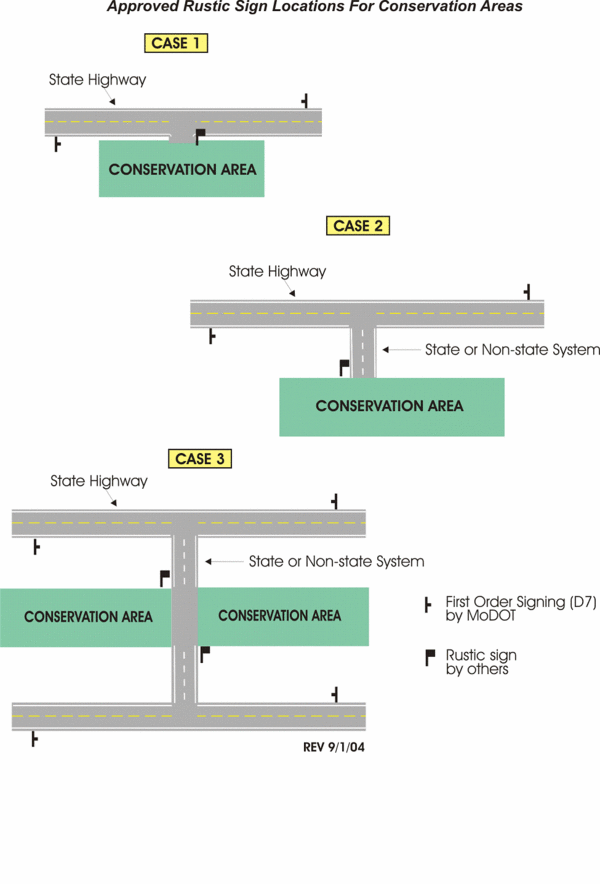903.13 State and Federal Recreation and Historic Site Signing
903.11.1 Scope (MUTCD Section 2H.01)
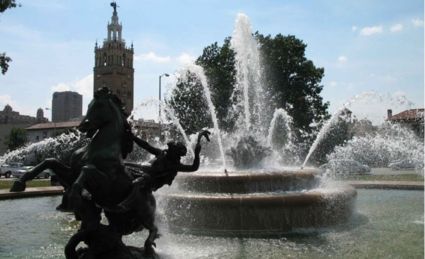
Support. Recreational or cultural interest areas are attractions or traffic generators that are open to the general public for the purpose of play, amusement or relaxation. Recreational attractions include such facilities as parks, campgrounds, gaming facilities and ski areas, while examples of cultural attractions include museums, art galleries and historical buildings or sites.
The purpose of recreation and cultural interest area signs is to guide travelers to a general area and then to specific facilities or activities within the area.
For the purpose of this chapter, recreational or cultural interest areas are state conservation areas, state parks, U. S. Corps of Engineers areas and U. S. Forestry Service areas. For privately owned recreational and cultural interest signs see the 903.8.39, Traffic Generator Policy.
Option. Recreational and cultural interest area signs may be used on freeways and expressways where there is direct access to these areas as discussed 903.11.9. Recreational and cultural interest area signs may be used off the road network, as appropriate.
903.11.2 Application (MUTCD Section 2H.02)
Support. Standards for signing recreational or cultural interest areas are subdivided into two different types of signs: (1) symbol signs and (2) destination guide signs.
Guidance. These signs are not to be used where they might be confused with other traffic control signs.
Option. Recreational and cultural interest area signs may be used on any road to direct persons to facilities, structures, and places and to identify various services available to the general public. These signs may also be used in recreational or cultural interest areas for signing non-vehicular events and amenities such as trails, structures and facilities.
903.11.3 Regulatory and Warning Signs (MUTCD Section 2H.03)
Standard. All regulatory and warning signs installed on public roads and streets within recreational and cultural interest areas shall conform to the requirements of 903.1 through 903.5. The sizes for recreational signs shall be as shown in Table 903.6.5.
903.11.4 General Design Requirements for Symbol Signs (MUTCD Section 2H.04)
Standard. Recreational and cultural interest area symbol signs shall be square or rectangular in shape and shall have a white symbol or message and white border on a brown background. The symbols shall be grouped into the following usage and series categories (see Standard Highway Signs for design details):
A. General Information (RG Series)
B. Motorist Services (RM Series)
C. Accommodation Services (RA Series)
D. Land Recreation (RL series)
E. Water Recreation (RW Series), and
F. Winter Recreation (RS Series)
Support. Table 903.11.7.2 contains a listing of the symbols within each series category. Drawings for these symbols are found in Standard Highway Signs (see 903.19.11).
Option. Mirror images of symbols may be used where the reverse image will better convey the message.
903.11.5 Symbol Sign Sizes (MUTCD Section 2H.05)
Guidance. Recreational and cultural interest area symbol signs should be 24 in. x 24 in. Where greater visibility or emphasis is needed, larger sizes should be used. Symbol sign enlargements should be in 6-in. increments.
Recreational and cultural interest area symbol signs should be 30 in. x 30 in. when used on freeways or expressways.
Option. A smaller size of 18 in. x 18 in. may be used on low-speed, low-volume roadways and on non-road applications.
903.11.6 Use of Educational Plaques (MUTCD Section 2H.06)
Guidance. Educational plaques should accompany all initial installations of recreational and cultural interest area symbol signs. The educational plaque should remain in place for at least 3 years after the initial installation. If used, the educational plaque should be the same width as the symbol sign.
Option. Symbol signs that are readily recognizable by the public may be installed without educational plaques.
Support. Figure 903.11.9.1 illustrates some examples of the use of educational plaques.
903.11.7 Use of Prohibitive Slash (MUTCD Section 2H.07)
Standard. The red diagonal slash, if used on a recreational and cultural interest area sign, shall be placed from the upper left corner to the lower right corner of the sign face (see Figure 903.11.9.1). Requirements for retroreflection of the red slash shall be the same as those requirements for legends, symbols, and borders.
Option. Where it is necessary to indicate a restriction within a recreational or cultural interest area, a red diagonal slash may be used to indicate that the activity is prohibited.
Support. Figure 903.11.9.1 illustrates some examples of the use of prohibitive slashes.
Table 903.11.7.1 Recreational Sign Sizes
| Sign | Sign Number | Section | Conventional | Expressway (At Grade) | Freeway (Speed Separated) | Other |
|---|---|---|---|---|---|---|
| PUBLIC AREA DIRECTIONAL (NARROW) | D7-1(A/R/L)-36 | 903.11.9 | 36 x 48 | 36 x 48 | - | 36 x 48 (ramp) |
| PUBLIC AREA DIRECTIONAL | D7-1(A/R/L)-72 | 903.11.9 | 72 x 24 | 72 x 24 | - | 72 x 24 (ramp) |
Table 903.11.7.2 Guide Sign Sizes (Sheet 1 of 2)
| GENERAL INFORMATION | ACCOMMODATION SERVICES | WATER RECREATION |
|---|---|---|
| Automobile RG - 010 | Airport RA - 010 | Boat Tours RW - 010 |
| Bear Viewing Area RG - 020 | Bus Stop RA - 020 | Canoeing RW - 020 |
| Dam RG - 030 | Campfire RA - 030 | Diving RW - 030 |
| Deer Viewing Area RG - 040 | Elevator * RA - 040 | Diving (Scuba) RW - 040 |
| Drinking Water RG - 050 | Kennel RA - 050 | Fishing RW - 050 |
| Environmental Study Area RG - 060 | Laundry RA - 060 | Marine Recreation Area RW - 060 |
| Falling Rocks * RG - 070 | Locker * RA - 070 | Motorboating RW - 070 |
| Firearms RG - 080 | Parking RA - 080 | Ramp (Launch) RW - 080 |
| Fish Hatchery RG - 090 | Rest Room (Men) * RA - 090 | Rowboating RW - 090 |
| Information RG - 100 | Rest Room (Women) *RA - 100 | Sailboating RW - 100 |
| Leashed Pets * RG - 110 | Shelter (Sleeping) * RA - 120 | Skiing (water) RW - 110 |
| Lighthouse RG - 120 | Shelter (Trail)* RA - 120 | Surfing RW - 120 |
| Litter Container RG - 130 | Showers * RA - 130 | Swimming RW - 130 |
| Lookout Tower RG - 140 | Family Rest Room * RA - 150 | Wading RW - 140 |
| Ped Xing * RG - 150 | Helicopter RA - 160 | Fishing Pier RW - 160 |
| Point of Interest RG - 160 | - | Hand Launch RW - 170 |
| Ranger Station RG - 170 | - | Kayak RW - 190 |
| Smoking * RG - 180 | - | Wind Surf RW - 210 |
| Truck RG - 190 | - | - |
| Tunnel RG - 200 | - | - |
| Dog RG - 240 | - | - |
| Seaplane RG - 260 | - | - |
| MOTORIST SERVICES | LAND RECREATION | WINTER RECREATION |
| Camping (Tent) RM - 010 | Amphitheater RL - 010 | Skating (ice) RS - 010 |
| Camping (Trailer) RM - 020 | Climbing RL - 020 | Ski Jumping RS - 020 |
| Ferry RM - 030 | Climbing (Rock) RL - 030 | Skiing (Bobbing) RS - 030 |
| First Aid RM - 040 | Hunting RL - 040 | Skiing (Cross Country) RS - 040 |
| Food RM - 050 | Playground RL - 050 | Skiing (Downhill) RS - 050 |
| Gas RM - 060 | Rock Collecting RL - 060 | Sledding RS - 060 |
| Grocery Store RM - 070 | Spelunking RL - 070 | Snowmobiling RS - 070 |
| Handicapped RM - 080 | Stable RL - 080 | Snowshoeing RS - 080 |
| Lodging RM - 090 | Trail (Bicycle) RL - 090 | Winter Recreation Area RS - 090 |
| Mechanic RM - 100 | Trail (Hiking) RL - 100 | Chairlift RS - 100 |
| Post Office RM - 110 | Trail (Horse) RL - 110 | - |
| Picnic Area RM - 120 | Trail (Interpretive, Auto) RL - 120 | - |
| Picnic Shelter RM - 130 | Trail (Interpretive, Ped.) RL - 130 | - |
| Rest Room RM - 140 | Trail/Road (4 WD Veh.) RL - 140 | - |
| Telephone RM - 150 | Trail (Trail bike) RL - 150 | - |
| Trailer Sanitary Station RM - 160 | Tramway RL - 160 | - |
| Viewing Area RM - 170 | All-Terrain Vehicle RL - 170 | - |
| Motor Home RM - 200 | Archer RL - 190 | - |
| Group Camping RM - 210 | Hang Glider RL - 210 | - |
| Group Picnicking RM - 220 | - | - |
| 24-Hour Pharmacy RM - 230 | - | - |
| * For non-road use | ||
Support. Figure 903.11.9.3 illustrates typical height and lateral mounting positions. Figure 903.11.9.4 illustrates some examples of the placement of symbol signs within a recreational or cultural interest area. Figure 903.11.9.5 illustrates some of the symbols that can be used.
Guidance. Signing for specific facilities, such as picnic areas, boat ramps, fishing access, etc., within state or federal major traffic generators will be the responsibility of the respective agency and will be allowed at the point of first order signing (See Figure 903.11.9.4). The number of symbols used in a single sign assembly is not to exceed four.
Option. Symbols for recreational or cultural interest areas may be used as legend components for a directional sign assembly. The symbols may be used singularly, or in groups of two, three or four on a single sign assembly (see Figures 903.11.9.1, 903.11.9.3 and 903.11.9.4). Smaller-size secondary symbols (see Figure 903.11.9.1)) may be placed beneath the primary symbols, where needed.
903.11.8 Placement of Recreational and Cultural Interest Symbol Signs (MUTCD Section 2H.08)
Standard. If used, recreational and cultural interest area symbol signs shall be placed in accordance with the general requirements contained in 903.1 outside the MoDOT road system. The symbol(s) shall be placed in the uppermost part of the sign assembly and the directional information shall be placed below the symbol(s).
Where the name of the recreational or cultural interest area facility or activity is shown on a general directional guide sign and a symbol is used, the symbol shall be placed below the name.
Recreational and cultural interest area symbols installed for non-road use shall be placed in accordance with the general sign position requirements of the authority having jurisdiction.
Support. Figure 903.11.9.3 illustrates typical height and lateral mounting positions. Figure 903.11.9.4 illustrates some examples of the placement of symbol signs within a recreational or cultural interest area. Figure 903.11.9.5 illustrates some of the symbols that can be used.
Guidance. Signing for specific facilities, such as picnic areas, boat ramps, fishing access, etc., within state or federal major traffic generators will be the responsibility of the respective agency and will be allowed at the point of first order signing (See Figure 903.11.9.4). The number of symbols used in a single sign assembly is not to exceed four.
Option. Symbols for recreational or cultural interest areas may be used as legend components for a directional sign assembly. The symbols may be used singularly, or in groups of two, three or four on a single sign assembly (see Figures 903.11.9.1, 903.11.9.3 and 903.11.9.4). Smaller-size secondary symbols (see Figure 903.11.9.1) may be placed beneath the primary symbols, where needed.
903.11.9 Destination Guide Signs (MUTCD Section 2H.09)
Guidance. When recreational or cultural interest area destinations are shown on supplemental guide signs, the sign should be rectangular with a white legend and border on a brown background.
These signs should be erected in the vicinity of state conservation areas, state parks, state historic sites, U.S. Corps of Engineers areas and U.S. forestry service areas. This sign will show the name of the area, type of area, directional arrow and the distance in miles to the area. For distances less than 10 miles, mileage will be indicated as miles plus tenths. For distances 10 miles or greater, whole mile increments will be used. A logo of the owning agency may be included on the sign. If the agency requests use of their logo, this information should be included on the requisition for the sign.
Standard. The requesting agency will be responsible for the cost of the signs; MoDOT will cover the cost to install these signs. Traffic will determine the cost. These signs shall be on a separate requisition grouped by agency if necessary. This is done to allow the agencies to approve the replacement of the signs prior to manufacturing. The Controller’s Office will bill the agency for the cost of the signs. A TR-15 contract will be executed.
First, second and third order signing can be provided for public non-profit agencies where space allows. First, second and third order signing will be provided as shown in Figure 2A-XX and Figure 903.11.10. Only numbered routes will be considered for second and third order signing. The requesting state or federal major traffic generators will be responsible for all material cost of these signs; MoDOT will cover the cost to install these signs. See 903.2.16, Signing Paid for by Others.
Option. White-on-brown destination guide signs may be posted at the first point where an access or crossroad intersects a highway where recreational or cultural interest areas are a significant destination along conventional roads, expressways or freeways. White-on-brown supplemental guide signs may be used along conventional roads, expressways or freeways to direct road users to recreational or cultural interest areas. Where access or crossroads lead exclusively to the recreational or cultural interest area, the advance guide sign and the exit direction sign may be white-on-brown.
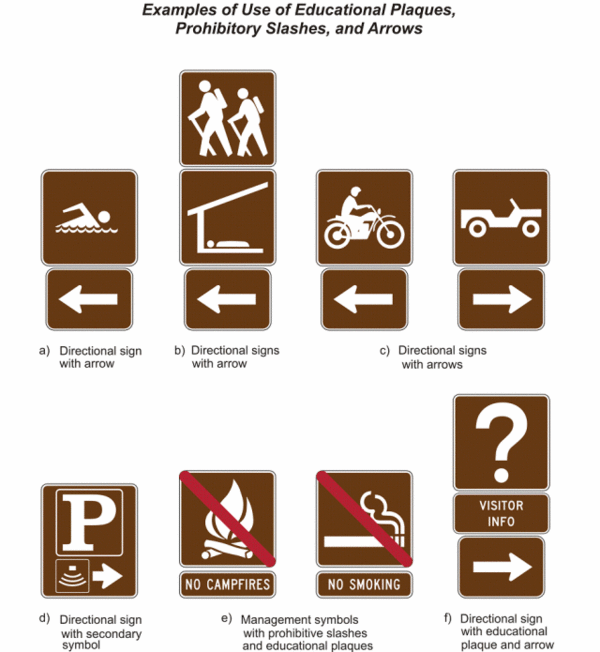
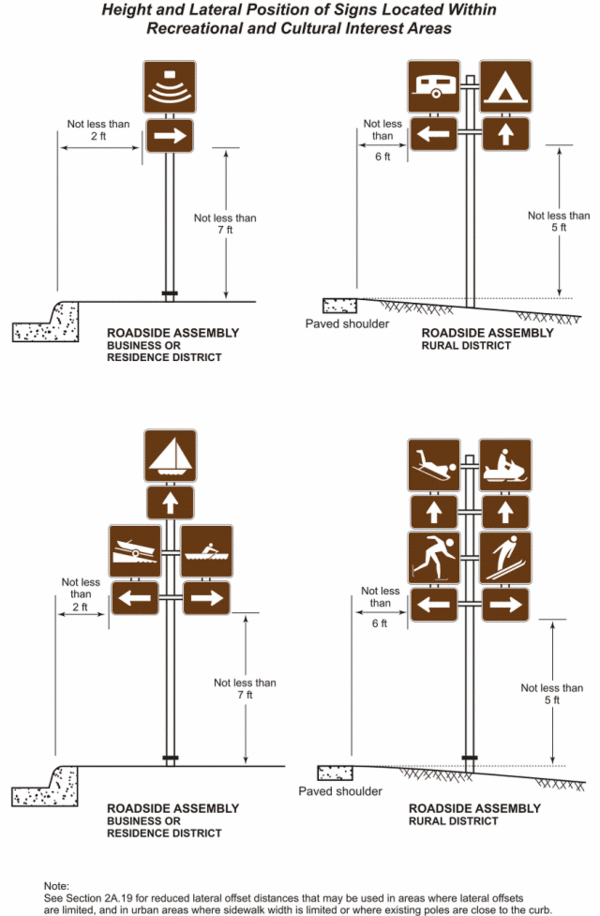
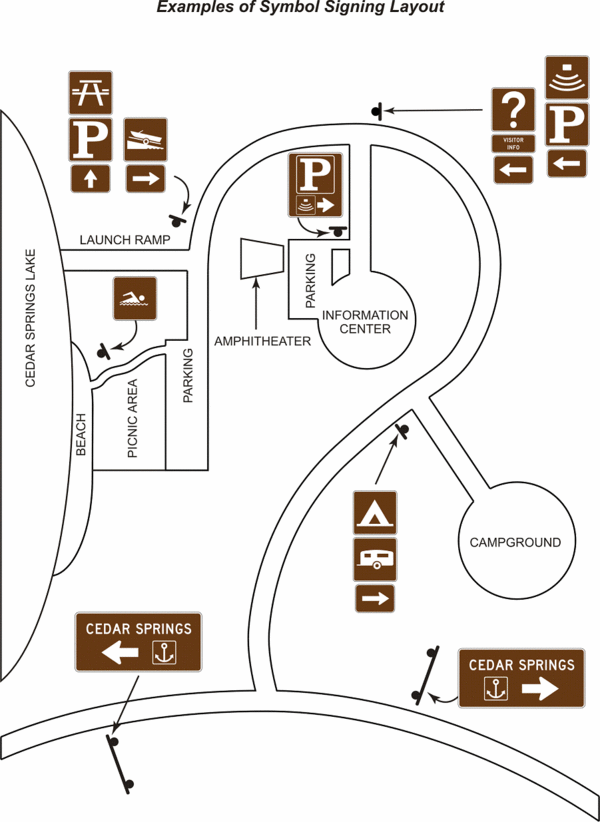
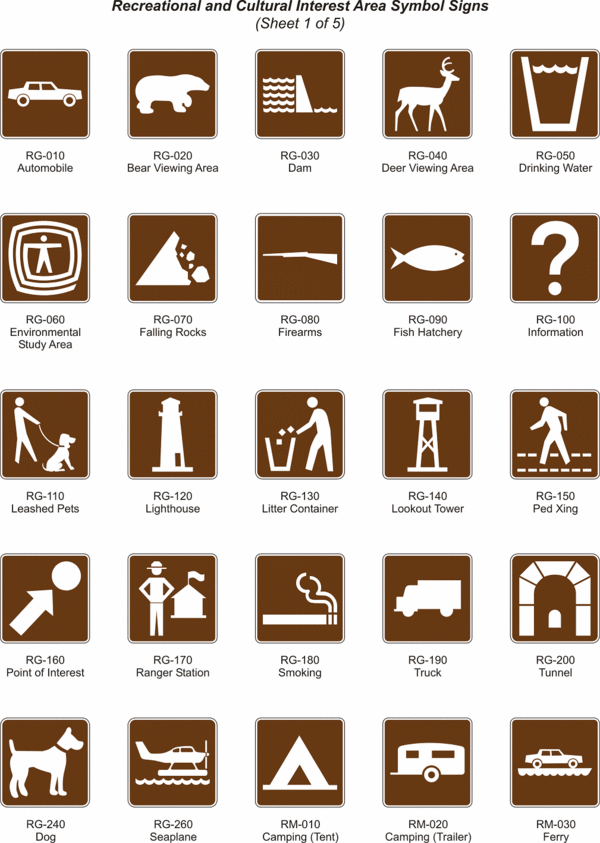
Standard. Linear parkway-type highways that primarily function as arterial connectors, even if they also provide access to recreational or cultural interest areas, shall not qualify for the use of white-on-brown destination guide signs. Directional guide signs used on these highways shall conform to 903.7.
All gore signs shall have a white legend and border on a green background. The background color of the interchange exit number panel shall match the background color of the guide sign. Design characteristics of conventional road, expressway or freeway guide signs shall conform to 903.7 or 903.8 except as specified in this article for color combination.
The advance guide sign and the Exit Direction sign shall retain the white-on- green color combination where the crossroad leads to a destination other than a recreational or cultural interest area.
Support. Figure 903.11.9.2 illustrates destination guide signs commonly used for identifying recreational or cultural interest areas or facilities.
903.11.10 National Park Signs (MUTCD Section 2H.10)
Standard. All national parks in Missouri shall be included in the recreational area signing program.
Signing for parks that are classified major area generator shall be located where the principal access highways intersect the National Highway System.
Support. Presently, there are two parks that would be provided signing under the major area generator classification: Jefferson National Expansion Memorial and Ozark National Scenic River Ways.
